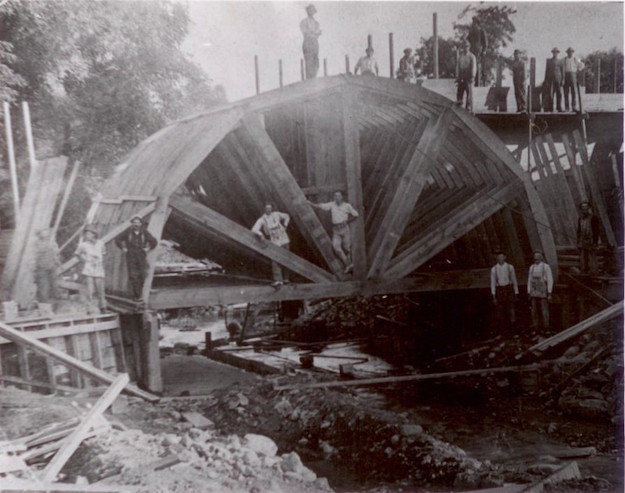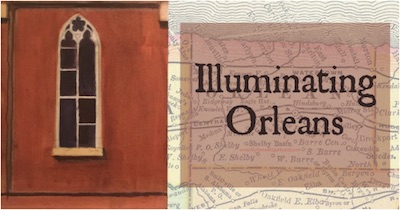Early settlers built bridges, moved ditches

Bridge building, Jeddo, 1916, Orleans County History Department collection.

By Catherine Cooper, County Historian – Vol. 1, No. 2
RIDGEWAY – Part of the fascination of local history is that it adds layers of depth to our experience of our surroundings.
The accompanying photograph is of men building a bridge at Jeddo in 1916. However, the background brings into consideration several factors: the determination of the early settlers, how a determined re-routing of water led to the formation of a vibrant settlement, and an appreciation of oral history for preserving the details that enhance the story.
On June 11, 1916, the steel bridge spanning Jeddo Creek on Ridge Road collapsed and fell into Johnson Creek. The Medina Daily Journal of June 12, 1916 reported:
“The water raised so high Saturday and Sunday that it washed out the abutments and foundation of the bridge spanning the creek.”
Town of Ridgeway officials acted quickly. Highway Superintendent Harry Waldo and Town Supervisor Burt Smith declared the bridge a “total wreck” and on June 14 at a special meeting, the Town Board called for a proposition to raise taxes by the sum of $5,000 to construct a concrete archway or bridge over Jeddo Creek at Ridge Road, this proposition to be voted on July 5.
On June 22, 1916, it was reported that a “substantial temporary bridge which could be crossed by a detour has been completed over the creek at Jeddo, consequently travel on the Ridge highway will not be interrupted while the stone arch, planned to take the place of the old bridge, is being erected.”
This bridge was completed by November.
The 1916 bridge collapse was not the first such at Jeddo. A severe flood in 1897 washed out a dam and the foundation of the mill. Yet another flood occurred in 1902. Jeddo residents may have wondered if these occurrences were the result of a stealthy re-routing of the creek by earlier settlers. This intriguing item of local lore has thankfully been preserved in an oral history interview conducted by former Historian Arden McAllister with Horace Bird in 1978.
According to Mr. Bird, the land around the Jeddo area was wet and swampy, and was referred to as “Wild Cat Swamp.” The creek then was but a stream which moved sluggishly along the south side of Ridge Road and joined the Oak Orchard River south of Ridgeway Corners.
Pioneer settler, Jeremiah Brown, took his oxen and dug a trench across Ridge Road to divert the water. Farmers on the north side were furious as their land flooded, so they filled in the trench. Jeremiah persisted with re-digging the trench and soon the volume of water draining north created a channel which joined with Johnson Creek and necessitated the construction of a bridge. The drained farmland proved very suitable for fruit orchards. The volume of water proved suitable for a mill and soon the settlement grew to include a saw mill as well as a cooperage, a blacksmith shop, a store, and for some time, a jelly factory.
Too often, we traverse historic Route 104, aware of the hamlets only as areas to reduce speed. Next time, take note of the jaunty oversize bowling pins at Jeddo Mills Antiques and salute the determination of the settlers, bridge builders, millers and merchants who lived there.
To access newspaper articles: www.nyshistoricnewspapers.org.
Transcripts of the Orleans County Oral Histories are available at Lee-Whedon Memorial Library, Medina, and Hoag Library, Albion.







































































